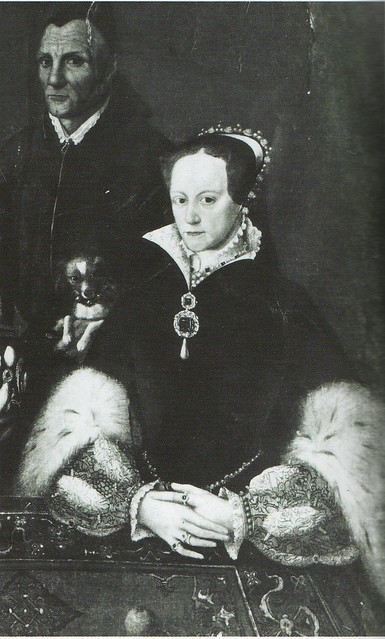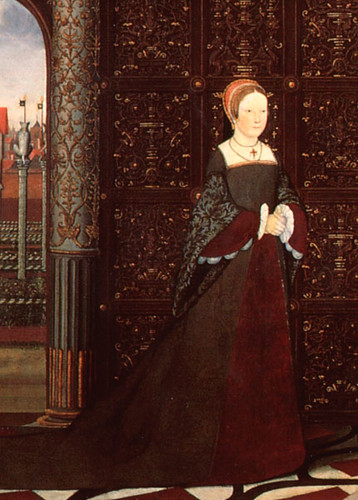Mary's Coronation

Portrait of Mary – from a painting depicting Mary, her father Henry VIII and the court jester, Will Sommers. Behind Mary stands the jester who is carrying a small dog which was fashionable amongst the elite at that time.
Mary’s coronation was recorded in the Chronicle of Queen Jane and of Two Years of Queen Mary, and especially of the Rebellion of Sir Thomas Wyat. It occurred on ‘the first daie of October, 1553’, the day after her procession through London. According to the account:
"..she cam first by water to the old palice [1] and ther tarryed tyll about xi of the clocke, and then went to the churche on foot apon blew cloth being rayled on every syde..."
There was some disagreement among contemporary commentators about how Mary was dressed in the coronation procession. Interestingly on the day itself there was no confusion. She wore a ‘chrymesyn vellvert gown’ with a crown on her head, whilst her hair was left loose. The colour of the gown was significant and the fact that contemporaries noted it precisely indicates its importance. Mary had chosen to dress in a colour worn by the male monarch at his coronation instead of adopting white and gold, colours which the queen consort traditionally wore when she was crowned. Yet Mary was not a queen consort nor did she wish to present herself as such. She was a monarch in her own right and to illustrate her authority she chose to be crowned like a king. It is important to remember that Mary had no precedent to tell her how an English queen regnant was to be crowned, thus she was forming her own standard. She was stating that despite her sex she would govern with the same authority as her male predecessors. There was another reason behind her attempts to emphasis her power. Technically Mary had inherited the throne as a royal bastard; her father had made her illegitimate and whilst he had provided her with a place within his succession and her right to govern was supported by the overwhelming majority, she was still not considered under law to be Henry VIII’s legitimate child. The accession of an illegitimate individual, even one whose right to succeed had been confirmed by parliament, was rather unprecedented [2]. Whilst she had received support she understood that her illegitimate state could be used against her – in fact it had been used against her by her brother and Jane Grey’s supporters. Mary rectified this by passing a parliamentary bill that stated her parents had been legally married. But this occurred after her coronation so Mary was to be crowned whilst illegitimate, something which she personally regarded as unjust. Therefore her attempts to enforce her authority were in defiance to her father’s judgement, her brother’s judgment and also those who had sided with Jane Grey. And it was also an indication of the decision on her parents’ marriage that she knew parliament would shortly reach.
No image of Mary from her coronation survives although in this Great Seal of Mary I and Philip of Spain, 1554, she is depicted with her hair loose, in official robes, wearing a crown, touching the orb and with the sceptre in her hand. This gives us some idea of the way she looked at her coronation.Mary was determined to be crowned ‘according to the olde custome’ as opposed to the manner in which the Protestant Edward VI had been crowned. According to the Imperial ambassador, Simon Renard, "the bishops and priests [were] in full canonical dress" which was a move away from the attack on rich clerical vestments that had occurred in the previous reign. Mary objected to being anointed with the oils used in her brother’s coronation, arguing that they had been tainted by their use in a Protestant ceremony. Thus she wrote to the bishop of Arras in Brussels for a new ‘uncontaminated’ supply of holy oil. Years later when Elizabeth I was preparing her own coronation she complained that the holy oils used for Mary were now ‘grease and smelt ill’. They may have become rather stale, or perhaps Elizabeth was taking a page out of her sister’s book and removing elements that were connected to the previous opposing regime.
 At the start of the ceremony two noblemen led Mary to each corner of a built dais so the whole congregation could see her. The man who presided over the ceremony and crowned her was the religious conservative Stephen Gardiner, bishop of Winchester who Mary made her Lord Chancellor. Once Mary had been shown to the congregation he stated aloud:
At the start of the ceremony two noblemen led Mary to each corner of a built dais so the whole congregation could see her. The man who presided over the ceremony and crowned her was the religious conservative Stephen Gardiner, bishop of Winchester who Mary made her Lord Chancellor. Once Mary had been shown to the congregation he stated aloud:“Sirs, Here present is Mary, rightful and undoubted inheritrix by the Laws of God and man to the Crown and Royal Dignity of this realm of England, France and Ireland, whereupon you shall understand that this day is appointed by all the peers of this land for the consecration, injunction and coronation of the said most excellent Princess Mary; will you serve at this time and give your wills and assent to the same consecration, unction and coronation?”
To which the crowd responded "Yea, yea, yea! God save Queen Mary!"
A sermon was subsequently delivered by George Day, bishop of Chichester, who had been imprisoned in 1551 after he had refused to replace alters in churches in his diocese (and released upon Mary’s accession). His sermon called upon the populace to be obedient to their sovereign. Mary then knelt in front of the altar, pledged that she would always defend her subjects and administer justice in her lands. She then swore the oath, although there is some ambiguity about its wording. According to Anne Whitelock, Mary feared that the coronation oath would be tampered with in order to make her state that she would promise uphold the current faith in England (therefore the Protestant Church of England). Thus to the oath she added the term ‘just and licit laws’ to indicate that she would uphold those laws which she regarded as lawful. In that sense she was not bound to maintain her brother’s church and had flexibility in instituting her religious objectives.
After then prostrating herself before the high altar, she was anointed by Bishop Gardiner with the holy oils. She was then dressed in the robes of state, handed the sword, sceptre and the orbs to indicate her power, and then crowned with the crown of St Edward the Confessor. She also had a personal crown made, which may have been later used by Elizabeth. Anne Whitelock notes that this specially made crown was ‘a vast yet simple designed crown with two arches, a large fleur-de-lis and prominent crosses’ (p. 196).
There were limits to Mary’s attempts to have her coronation completely resemble a king’s. A king was supposed to have the ceremonial spurs placed upon him although this was regarded as unseemly for a queen to do, thus Mary just touched them. Then there was the question of making new Knights of the Bath. It was traditional for the monarch to create new knights at the time of the coronation and this involved a ceremony in which the naked knights would be plunged in a bath and the monarch would kiss their shoulder. But as Renard notes, “the Queen being a woman, the ceremony was performed for her by the Earl of Arundel, her Great Master of the Household”.
The whole ceremony lasted from around eleven o’clock to four o’clock that afternoon. Immediately following the ceremony she attended the sumptuous coronation banquet. Overall the day had gone off without a hitch.
However there had been a notable absence – the archbishop of Canterbury. Whilst Mary was being anointed as England’s first queen regnant, Thomas Cranmer was in the Tower having been arrested for his involvement in attempting to place Jane Grey on the throne. There was of course another reason for his imprisonment; it is notable that he was then sharing lodgings with a number of other Protestant clergymen. From Mary’s point of view it was absolutely inconceivable that she would be crowned by this man and in the end she managed to orchestrate his absence and replace him with Bishop Gardiner (who had been imprisoned himself during Edward VI’s reign). Mary was clearly stating that it was a time for ‘out with the old, in with the new’. Or perhaps more accurately, out with the new and back with the old.
Overall Mary’s coronation had been a triumph and a time for genuine celebration. Yet after the festivities finished Mary faced the difficult task of living up to the image she created for herself – that of an independent queen regnant who would govern like any man before her. She would face significant problems, even be the subject of a damning critique against female rule [3]. But by and large she made everyone know who was boss. We can hardly expect anything less of a Tudor!
~~~~~~~~~~~~~~~~~~~~~~~~~~~~~~~~~~~~~~~~
[1] A reference to Westminster Palace
[2] William I was also illegitimate and it is possible that Edward the Martyr’s parents were not married.
[3] John Knox’s infamous, The first blast of the trumpet against the monstrous regiment of women(1558), which argued that women by their nature were unfit to be authority figures, was originally written in response to the rule of Mary I.
References
Most of this is from another blog http://mary-tudor.blogspot.com/2009/05/marys-coronation-part-2-ceremony.html which I altered and edited, but felt to be relevant to my research.
Most of this is from another blog http://mary-tudor.blogspot.com/2009/05/marys-coronation-part-2-ceremony.html which I altered and edited, but felt to be relevant to my research.
Primary documents
John Gough Nichols (ed.), The Chronicle of Queen Jane, and of Two Years of Queen Mary, and especially of the Rebellion of Sir Thomas Wyat (London, 1850), pp. 27-32.
Letter from Simon Renard to Philip of Spain, 3rd October 1553, in Royall Tyler (ed.), Calendar of State Papers, Spain,Volume 11: 1553 (London, 1916), pp. 261-272.
Secondary sources
David Loades, Mary Tudor: A Life (Oxford, 1992), pp. 205-6.
Judith Richards, Mary Tudor (Oxon, 2008), pp. 137-9.
David Starkey, Elizabeth: Apprenticeship (London, 2000), p. 274.
Roy Strong, Coronation: A History of Kingship and the British Monarchy (London, 2005), pp. 192-3, 197-222.
Anna Whitelock, Mary Tudor: England’s First Queen(London, 2009), pp. 195-7.





